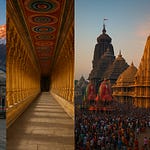India, with its vast history and cultural diversity, is home to some of the most extraordinary ancient architectural marvels. While the Taj Mahal and Jaipur's palaces dominate tourist itineraries, many incredible ancient sites remain underrated and underexplored. Here, we delve into five such gems – Konark Sun Temple, Hampi, Pattadakal, Khajuraho, and Gangaikonda Cholapuram – each standing as a testament to India’s glorious past.
1. Konark Sun Temple (Odisha)
Built by: King Narasimhadeva I of the Eastern Ganga Dynasty (13th century)
Significance: UNESCO World Heritage Site
History and Architecture:
The Konark Sun Temple, dedicated to Surya (the Sun God), is a striking architectural marvel resembling a colossal chariot with 24 intricately carved wheels and seven horses. Built in the 13th century, this temple exemplifies Kalinga architecture at its finest.
The temple walls feature magnificent carvings of dancers, musicians, animals, and celestial beings, capturing life in ancient times. The wheels are sundials that can accurately calculate time to the minute.
Why It’s Underrated: Despite its global recognition, the Sun Temple at Konark often takes a backseat to Odisha's more frequented destinations like Puri and Bhubaneswar. This temple, however, remains one of India's most striking and awe-inspiring ancient structures.
2. Hampi (Karnataka)
Built by: Vijayanagara Empire (14th-16th century)
Significance: UNESCO World Heritage Site
History and Architecture:
Hampi was once the flourishing capital of the Vijayanagara Empire, one of the wealthiest empires in South Indian history. Today, it stands as a vast open-air museum, featuring temple complexes, royal enclosures, and market streets.
The Virupaksha Temple is one of the oldest active temples in India, while the iconic stone chariot at the Vittala Temple Complex reflects advanced craftsmanship and spiritual devotion. Hampi's landscape, dotted with massive boulders and ruins, adds a surreal aura to the place.
Why It’s Underrated: Despite being India’s largest archaeological site, Hampi often gets overshadowed by other South Indian landmarks like Mysore Palace or Bangalore’s tech hub. However, Hampi’s vast ruins offer an unparalleled glimpse into medieval South India.
3. Pattadakal (Karnataka)
Built by: Chalukya Dynasty (7th-8th century)
Significance: UNESCO World Heritage Site
History and Architecture:
Pattadakal served as the ceremonial coronation site for Chalukya kings. This complex uniquely blends North Indian Nagara and South Indian Dravidian architectural styles. The Virupaksha Temple in Pattadakal, constructed by Queen Lokamahadevi, commemorates the Chalukya victory over the Pallavas.
Several smaller temples in the vicinity, such as the Mallikarjuna and Papanatha temples, exhibit exquisite carvings and elaborate sculptures portraying scenes from Hindu epics like the Ramayana and Mahabharata.
Why It’s Underrated: Pattadakal is often eclipsed by nearby Badami and Aihole, despite being the crowning jewel of Chalukyan architecture.
4. Khajuraho (Madhya Pradesh)
Built by: Chandela Dynasty (950-1050 AD)
Significance: UNESCO World Heritage Site
History and Architecture:
Khajuraho's temples are famed for their intricate erotic sculptures and detailed carvings, which symbolize the Tantric belief in the intertwining of spirituality and physicality. The site originally housed over 85 temples, of which around 20 have survived.
The Kandariya Mahadeva Temple is the largest and most exquisite, known for its elaborate towers and meticulously detailed carvings depicting gods, goddesses, celestial nymphs, and mythical creatures.
Why It’s Underrated: Khajuraho's somewhat remote location makes it less frequented by domestic tourists, despite its iconic international reputation.
5. Gangaikonda Cholapuram (Tamil Nadu)
Built by: Rajendra Chola I (11th century)
Significance: Part of the Great Living Chola Temples (UNESCO Site)
History and Architecture:
Gangaikonda Cholapuram was established by Rajendra Chola I to commemorate his victory over the kingdoms of the Ganges. The Brihadeeswarar Temple here, mirroring the temple in Thanjavur, showcases the pinnacle of Chola architecture.
The temple's towering vimana (pyramidal tower) is adorned with intricate carvings and sculptures. Its sanctum enshrines one of the largest Shiva Lingas in India, and the temple tank (called Cholagangam) was believed to be filled with Ganga water brought by the victorious Cholas.
Why It’s Underrated: Despite being a masterpiece of Chola craftsmanship, Gangaikonda Cholapuram remains less known than its counterpart in Thanjavur.
Why These Sites Deserve More Recognition:
Cultural Diversity: Each of these sites represents a unique architectural style and period in Indian history.
Spiritual and Artistic Heritage: The intricate carvings, symbolic sculptures, and temple designs reflect India’s rich artistic traditions.
Less Crowded: These ancient marvels offer a peaceful, immersive experience without the crowds found at more popular destinations.
Educational Value: Visiting these sites offers a deep understanding of India’s dynastic past and the evolution of temple architecture.
Each of these sites offers a unique glimpse into India's rich history and architectural diversity. By visiting these places, travelers can step back in time and experience the grandeur of empires that once flourished here. These destinations are not just monuments but stories etched in stone, waiting to be discovered.
Pro Tip: Plan your visit during off-peak seasons to truly immerse yourself in the history and serenity of these ancient sites.
Explore with DharmikVibes
To make your journey more enriching, consider exploring these ancient sites with DharmikVibes, a platform that seamlessly blends spiritual experiences with travel. DharmikVibes not only helps you plan visits to these historic places but also connects you with knowledgeable guides, organizes local rituals, and offers insights into the spiritual significance of these landmarks. Whether it’s temple rituals in Khajuraho or heritage walks in Hampi, DharmikVibes ensures a deeper connection with India’s spiritual and architectural past.
👉 For bookings and inquiries, reach out to us at:
📩 travel@dharmikvibes.com










